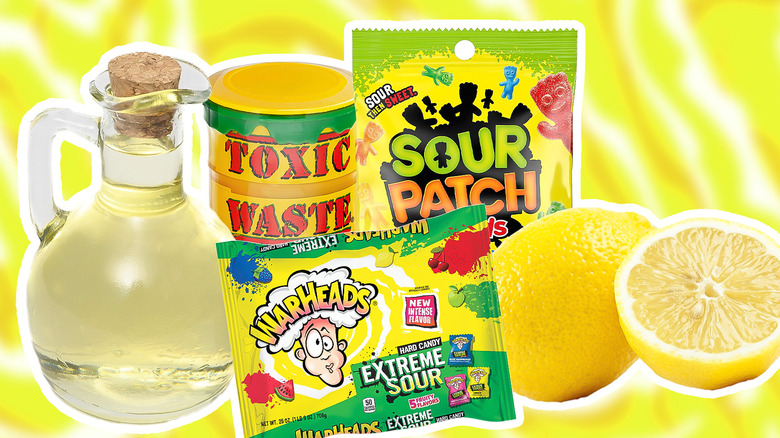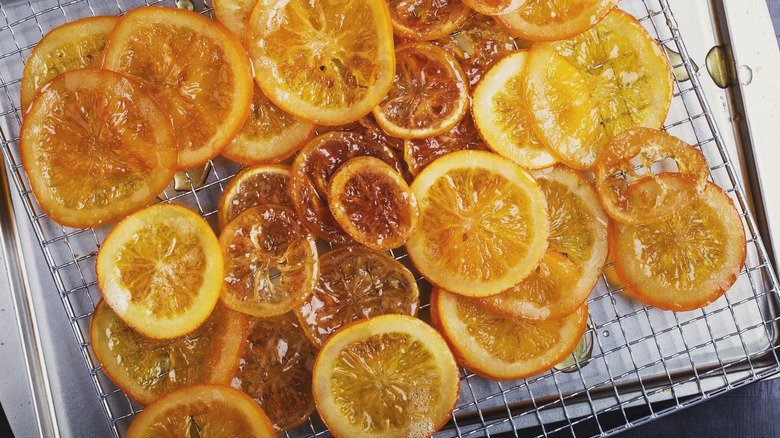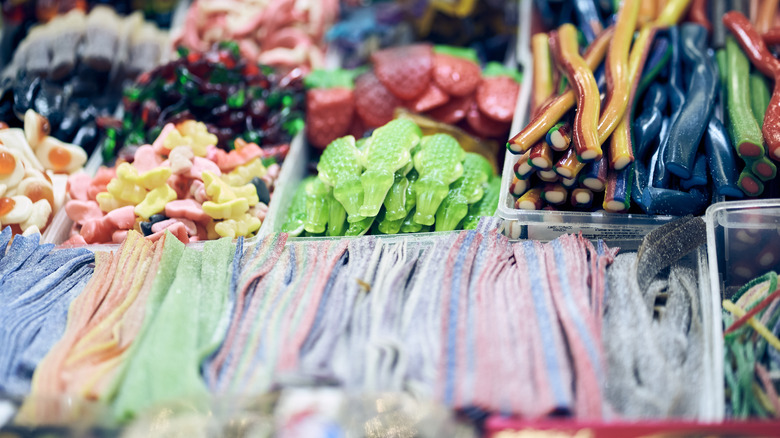The Evolution Of Sour Candy From Vinegar To Warheads Extreme
We may receive a commission on purchases made from links.
Over the years, a person's tolerance for sour candy has become something of a badge of honor. If you can handle the extreme pucker-inducing flavor of a Warhead, then you could handle pretty much anything. Of course, these false claims about candy-coated bravery were largely cooked up by the people who just want to see their friends squirm with discomfort as their tongue wages war with a sour treat. Regardless of what motivates people to seek out sour candies, it's become a multibillion-dollar industry that is only expected to grow over the years (via IndustryArc).
Anyone who has ever partaken in sour treats has likely questioned where candies like Sour Patch Kids, Sweet Tarts, or Lemonheads get their acidic kick — probably right before asking themselves, "Why am I eating this?" The truth is that today's sour candies — and our collective fascination with eating dangerously — have an interesting backstory. Much like the tale behind blue raspberry candy flavoring or marshmallow peeps, sour candy has an origin story worthy of today's celluloid superheroes.
A history of sweet and sour
The earliest attempts to make sour treats came from sour fruits. Ancient Greeks, Persians, and Egyptians experimented with lemon juice, pomegranates, and tamarind to contrast the sweetness of honey and fruit and bring sour flavors to the forefront. While experimenting with sour flavors has never really gone out of style, the candy industry didn't become the powerhouse that it is today until the early 19th century. Since vinegar's acidity can balance out overly sweet flavors, it's possible that early candy makers included vinegar in their recipes to help even things out a bit. When confectioners wanted to add a bit more tang, vinegar became the most likely suspect.
As candy production evolved, confectioners started to rely on naturally occurring acids. Tartaric acid, or cream of tartar, was the most prominent of these acidic additives, but citric acid started to become the primary ingredient for sour treats since it was derived from citrus fruits and better lent itself to candy production. Sour balls, Lemonheads and Regal Crown sour hard candies all used citric acid along with other flavors to create a trademark pucker.
Though sour candy has long been a part of the international candy lexicon, it was the Atomic Fireball that likely sparked candy fans' obsession with "dangerous" candy. Created by the Ferrara Pan Candy Company in Forest Park, Illinois, cinnamon-flavored Atomic Fireballs were designed to provide just as much pain as pleasure. Thanks to the "extreme" nature of these candies, modern confectioners started exploring the possibilities of extremely sour variations.
Warheads and other extreme sours
After the Atomic Fireball, candy companies began to explore the market of extreme candies which came to a chaotic head in the 1990s. The fad was covered in detail by Wired's Mark Frauenfelder, who wrote about the huge demand for gross-out or extreme candy which was heavily influenced by Mega Warheads. This particular brand of extremely sour candy was developed by Peter De Yager, founder of Hull, Iowa's Foreign Candy Company. After taking a deep dive in the extreme sour candies of Japan, Singapore, and Thailand, De Yager concocted a painful blend of malic, ascorbic, and citric acids that he applied to a standard fruit-flavored hard candy.
It's the malic acid that does most of the heavy lifting when it comes to extreme sours. Like citric acid, malic acid is derived from sour apples–this is what gives granny smith apples their trademark tartness. These days, sour candy aficionados on the r/candy subreddit highly recommend Great Britain's Barnetts Mega Sours which also use a combo of malic acid and citric acid. Those who really want to punish their taste buds will want to check out Black Death Mega Sours, another British treat that comes with a warning.
Based on reports of scorched taste buds and bruised lips that abound with today's most extreme sour candies, it will be interesting—and painful—to see what's next for the world of sour candies.


